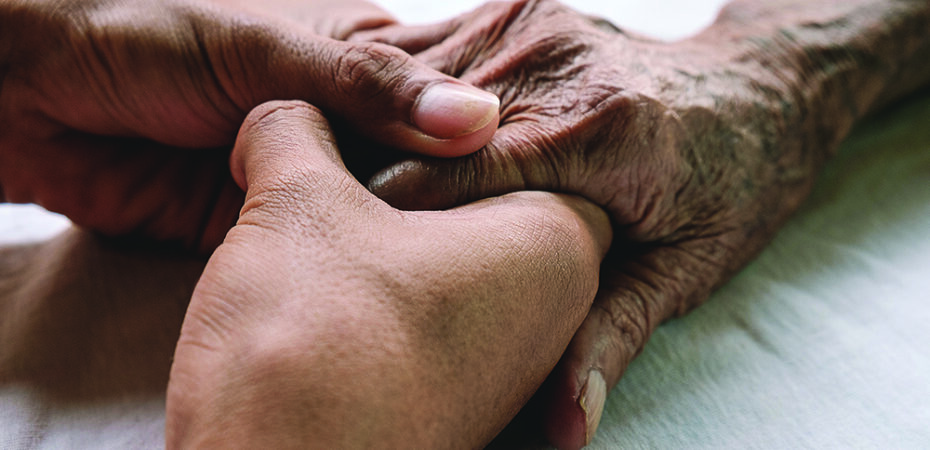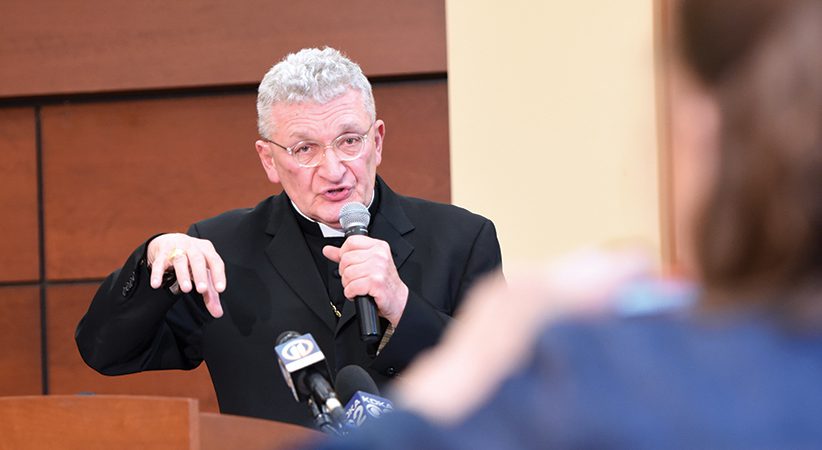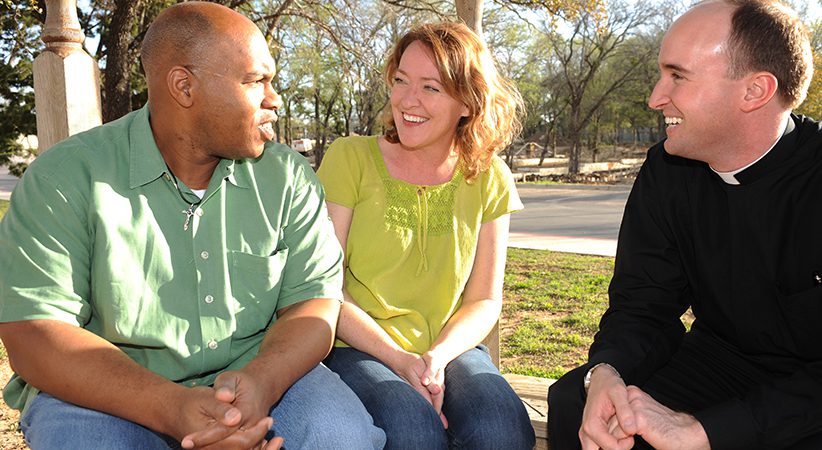Entering the Patient’s Chaos
Closing the distance between the patient and minister
Father David Gerard De Marco Comments Off on Entering the Patient’s Chaos
In the film “Dead Man Walking,” there is a striking moment of contrasting pastoral styles. As the condemned prisoner, Matthew Poncelet, walks to his execution, the prison chaplain, Father Farley, suddenly appears to offer his blessing — a dispassionate ritual performed from a safe distance. Meanwhile, Sister Helen Prejean, who risked meeting with Matthew one-on-one, now walks beside him with her hand on his shoulder. The scene enshrines the contrast between the priest’s distant approach to pastoral ministry and the more radically personal accompaniment of Sister Helen. This contrast transcends prison ministry and illuminates a critical dimension of the care of the sick.
As the Church prepares to observe World Day of the Sick 2022, it seems appropriate for us to consider the choice that confronts anyone who ministers to those living with a physical or psychological affliction.
…………………………………………………………………………………………………………………………………………………………
World Day of the Sick
Feb. 11 is World Day of the Sick, an observation introduced by Pope John Paul II as a way for believers to offer prayers for those suffering from illnesses. The day coincides with the commemoration of Our Lady of Lourdes and is an important opportunity for those who serve in Catholic health ministry to reflect on caring for those who are sick as well as those who provide care to them.
………………………………………………………………………………………………………………………………………………………….
Each one ministering to the sick — priest, deacon, hospital chaplain, physician or nurse — chooses, consciously or not, either to remain at a safe distance or risk more radical accompaniment. Such a minister chooses the degree of engagement — just as the three travelers in the parable of the good Samaritan choose theirs in responding to the “half-dead” victim lying in the road to Jericho. The one ministering to the sick chooses the degree to which he will surrender to the Spirit’s invitation to enter the patient’s chaos.
Henry George Plimmer (1856-1918), physician and lecturer at Saint Mary’s Hospital Medical School, London, wrote in 1899, “[It] is quite as important for the doctor to know what kind of patient the disease has for a host, as to know what kind of disease the patient has for a guest.”
This is a primordial description of what medical educators today call the patient-centered approach to health care. This approach orients the one ministering to the patient toward the patient’s health concerns and their interior landscape.

For the Christian minister, the patient-centered approach is a gateway to experiencing God in the encounter with a patient. It signals a willingness to move beyond providing a service. It signals a willingness to enter the patient’s chaos and be Christ for the patient (“But a Samaritan while traveling came near him; and when he saw him, he was moved with pity”) and sees Christ in the patient (“I was sick and you took care of me”).
The power of the patient-centered approach unfolded for me during my second year as an internal medicine resident at one of the nation’s largest quaternary health care and research centers. That year, the medical community was struggling to care for the rising tide of patients infected with the human immunodeficiency virus (HIV). By the time they were admitted to the hospital, almost all of these patients had advanced (and nearly always fatal) HIV infection, more commonly called acquired immunodeficiency syndrome (AIDS).
While the medical profession in 1986 knew something about the cause of HIV/AIDS and its transmission from person to person, it was largely powerless to stop its ravages. It is nearly impossible to overstate the fear, the shame and the devastation that attended the experience of patients living with HIV/AIDS. Some of the social currents of the day aggravated their emotional desolation and social isolation by declaring HIV/AIDS a sign of God’s wrath.
Fear Distorts Care
Fear also affected many caregivers, including nurses and physicians. We knew that our early infection-control measures in the hospital were often more draconian than was necessary — protocols driven more by fear than by science. For example, at one point in the academic year — just to enter a patient’s room — I had to stop at the door, remove my white coat, wash my hands, and then put on a surgical cap, a full-length surgical gown, gloves, a protective mask and shoe covers. On my way out, of course, I had to reverse the entire process. With all visitors so attired, these patients could easily conclude that they were social pariahs — the lepers of contemporary society.
One day, while making rounds in the hospital, my attending (or supervising) physician, reflected on the psychosocial drama of HIV/AIDS: “This disease evokes in patients a sense of tremendous shame and fear,” he observed, “but it also scares the daylights out of everyone else. Perhaps worst of all is the way we have allowed our fear to distort how we care for these patients. We find ways to keep them at arm’s length.”
………………………………………………………………………………………………………………………………………………………….
Prayer for Renewed Strength
The U.S. Conference of Catholic Bishop offers the following prayer for renewed strength:
“O Lord, my God, Please give me the grace to maintain my hope in you through all of life’s changes and to taste and see your goodness. I praise you for the gifts you have showered on me for so many years. Help me find joy in a renewed strength of spirit. Please bless me with good health, and inspire me to be a good example to others. For you are Lord, forever and ever. Amen.”
…………………………………………………………………………………………………………………………………………………………
Just as he finished saying this, he and I stopped at the door of the last patient on our rounds that day — a young man in his mid-20s with pneumocystis jirovecii pneumonia. At the door, I stopped and dutifully began the mandated infection-control ritual. However, amid my ablutions, I was suddenly aware that my attending was no longer standing beside me. He had brushed past the infection-control station and had walked right into the patient’s room. I was stunned.
When I looked up, he was already sitting on the edge of the patient’s bed, leaning toward the young man with his hand resting gently on the patient’s arm. As I stepped into the patient’s room, I heard my attending ask, “And how are you doing today?” The patient wore a wide-eyed look of shock. After all, he was used to seeing all of his caregivers covered from head to toe — and keeping a safe distance.
As I looked on, the patient’s expression changed from one of shock to one of relief — and then finally to catharsis with tears streaming down his face. He kept repeating, as if it were a mantra, “Thank you … thank you … thank you.” Someone had actually touched him. Someone had poured oil and wine on his wounds. Someone had drawn near. Someone had risked entering his chaos.
This encounter remains for me an enduring image of the patient-centered approach to caring for the sick — a willingness to close the distance between patient and minister, a willingness to enter the patient’s chaos, a willingness to be Christ for the patient and see Christ in the patient. It manifested concretely as my attending standing with a patient nonjudgmentally and listening actively with genuineness and empathy. And, notably, this encounter could have unfolded quite differently.
My attending could have chosen to stay at a distance — he could have crossed over to the other side of the road and stayed with the clinical facts. He could have been content knowing that the patient’s oxygen saturation level had improved overnight. Incidentally, he did learn that — but he accomplished so much more in the encounter as he accompanied the patient in his journey toward emotional and spiritual wholeness amidst a terminal illness.
Limited Chaos
Of course, I have witnessed missed opportunities, too — encounters in which the one ministering to the sick chose to stay at a safe distance. One day I found myself on the other side of the stethoscope preparing for my own abdominal surgery. The surgery was elective but necessary — and was performed by a technically masterful surgeon to whom I will always be deeply grateful.
However, his choice to keep a safe distance between himself and my interior landscape — his choice not to acknowledge the powerful affective experience I was having — taught me just what it is like when a caregiver chooses either not to enter the patient’s chaos, or to enter it in a profoundly limited way. The experience left me to fend for myself affectively, to find other resources that would help me find meaning amid suffering. It seemed like an opportunity missed. And it would only have cost him the willingness to help me hold my story for a moment with a question like, “How are you doing with all this?”
Holding the patient’s story — sometimes that is how it looks to enter the patient’s chaos. It looks like a caregiver willing to hold a patient’s story, even — and perhaps especially — when that patient cannot hold their own story because of its staggering weight.
A Trusted Safe Place
Dr. Richard Weinberg, M.D., an academic gastroenterologist in North Carolina, in his wonderfully poignant essay, “Communion,” describes his encounter with a young woman struggling since her teen years with debilitating chronic abdominal pain from severe irritable bowel syndrome. Before she met Weinberg, she had visited every other gastroenterology clinic in town. Weinberg observed about their first visit that his young patient was “huddled in the corner of the examining room, as if awaiting the executioner.” Although devoutly Catholic and attending daily Mass, she volunteered that she had long since stopped going to Communion — although she did not say why.
Weinberg soon discovered that the only thing he and his new patient could easily talk about was the art of baking — she was a professional baker and he was a dilettante. Week after week, they discussed this shared passion until one day Weinberg noticed that his young patient looked exhausted — like she had not been sleeping well. She confirmed his suspicion about sleeplessness, adding, “I have a nightmare.” When Weinberg asked what the nightmare was, the young woman disclosed such shockingly lurid imagery that he immediately asked if she had been a victim of sexual assault. “When I was 14,” she admitted in a barely audible voice, “by my oldest sister’s boyfriend.” She never reported the assault. In fact, she had never told anyone about it except Weinberg — at that very moment.
At that point, Weinberg admits, “I felt completely out of my depth.” He then tried referring his patient to a variety of mental health professionals — but she refused to see anyone else. Weinberg adds, “I then understood that having unearthed her dark secret, I had become responsible for her care.” The young woman then disclosed how sinful she felt after the rape, and how she had stopped going to Communion. At the same time, she started a binging-purging eating ritual that she was helpless to control.
After her disclosure, Weinberg noticed that with each successive visit his patient seemed less anxious. She stopped talking about her chronic abdominal pain. Her social horizon seemed to expand. She began to receive Communion once again. And one day, when she showed up, she seemed transformed — smiling radiantly as she took her leave of the clinic and reset her life.
Weinberg’s patient had so trusted the safe space he was able to create in their encounters that she gradually revealed to him the dark secret of her rape. But she shared her story with him alone. For his part, Weinberg learned that his patient had chosen him to hold her story. He had closed the distance between them — had risked entering her chaos to hold her traumatic story when she could not hold it by herself.
And the fruit borne was transformational — not only for his patient but for him. Weinberg concludes about the encounter: “I had been chosen to receive the gift of trust, and of all the gifts I had ever received, none seemed as precious. That afternoon I left the clinic feeling exhilarated and full of love for my profession.”
Options
Entering the patient’s chaos may look like my attending physician standing in solidarity with a young man dying of HIV/AIDS. Or it may look like Weinberg holding his patient’s horrible secret. Whatever shape it takes in the uniqueness of the relationship between the patient and the minister, the same choice lies open before us. We can minister to the sick at a safe distance and with maximum personal control. The physician can stay with the clinical facts. The priest can cleave to a dispassionate ritual. Or we can draw near to the patient and risk entering their chaos. If we choose the latter, then there — in the very midst of that chaos — we have an amazing opportunity and privilege to be Christ for the patient and see Christ in the patient. It is difficult to imagine a more fitting way to celebrate World Day of the Sick.
JESUIT FATHER DAVID GERARD De MARCO, M.D., is an internist in Broadview, Illinois.





